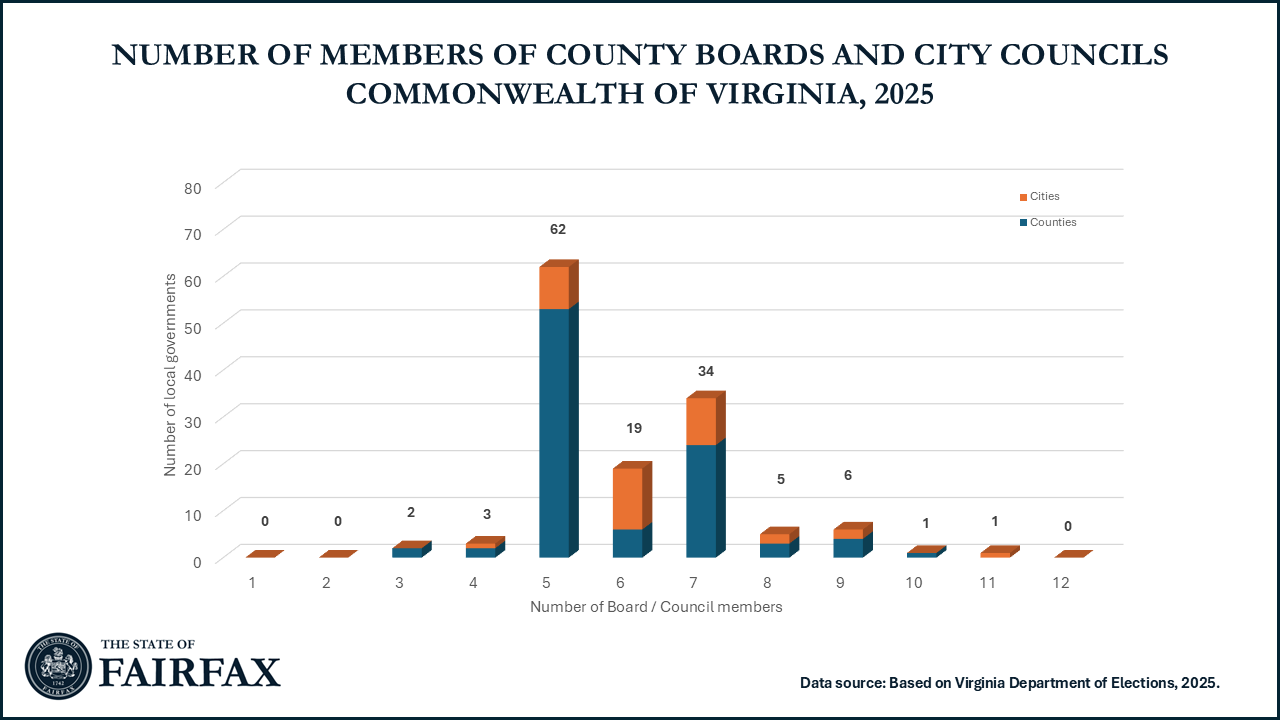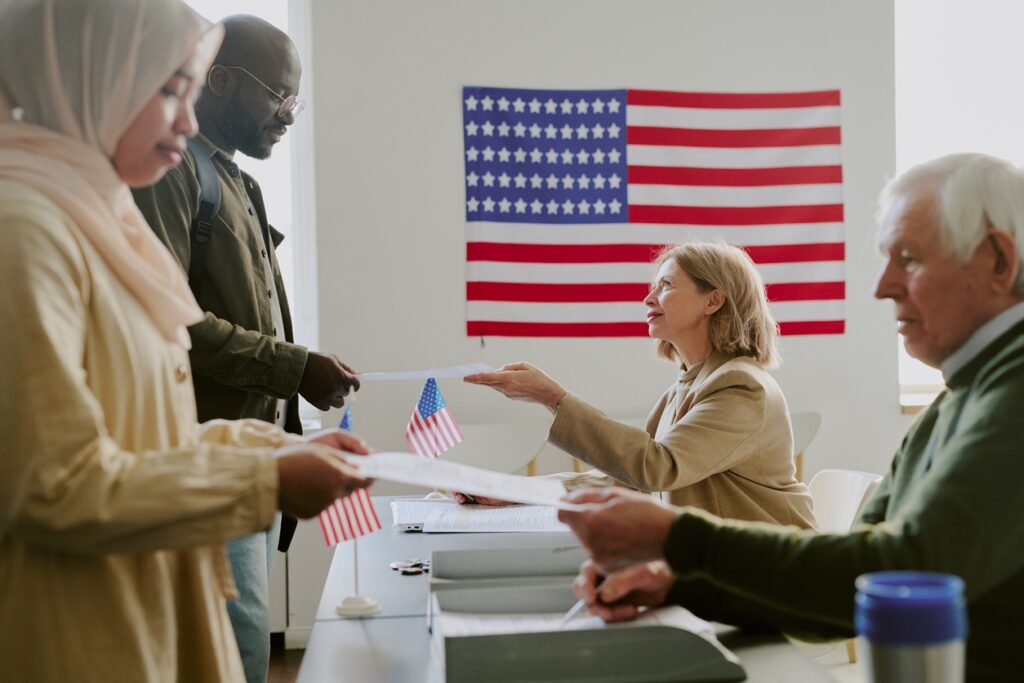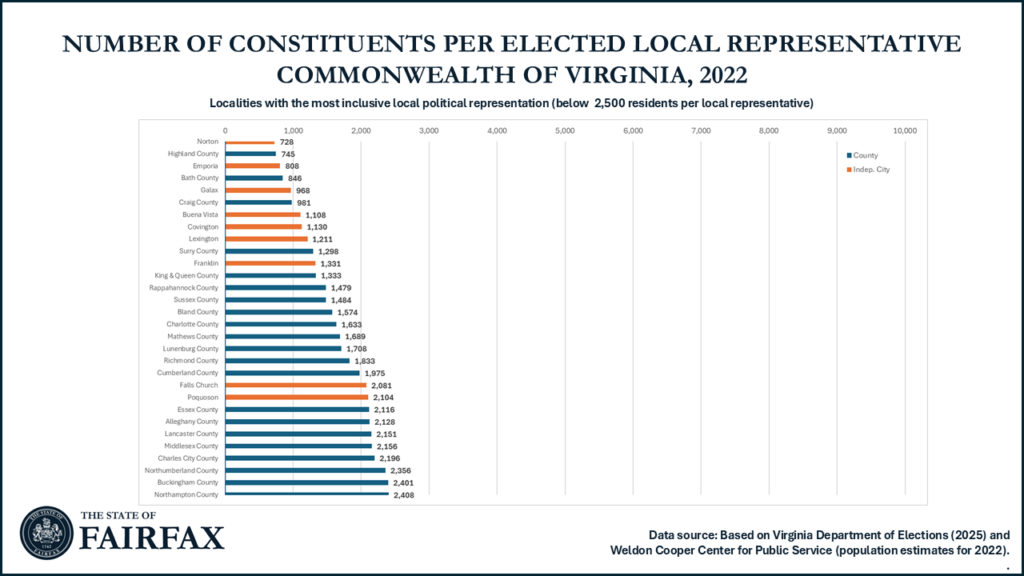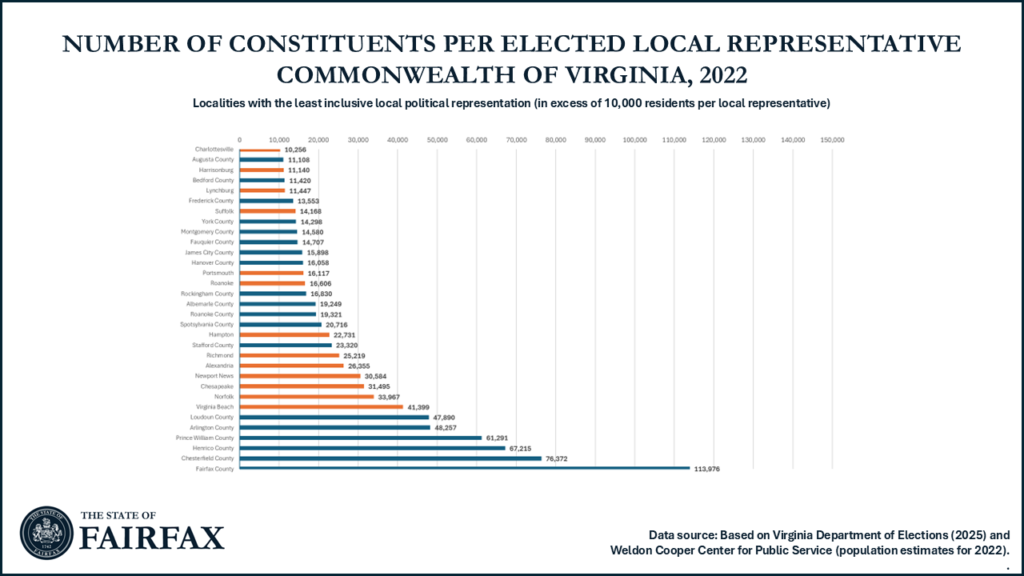Equal representation and equal justice under the law are important principles of American democracy. These principles include the notion that citizens should have more or less the same level of voice and political representation at different levels of government in our federal system.
For instance, the Fourteenth Amendment states that “Representatives shall be apportioned among the several states according to their respective numbers, counting the whole number of persons in each state” and that “[n]o state shall … deny to any person within its jurisdiction the equal protection of the laws.” Likewise, the Virginia Constitution and relevant laws strive for equal political representation, for instance, by stating that federal and state-level election “[d]istricts shall be so constituted as to give, as nearly as is practicable, representation in proportion to the population of the district.”
Given that the commonwealth has established local governments (counties, independent cities, and towns) so that citizens and communities can pursue their collective interests at the local level, an important—but often overlooked—part of political or electoral representation is the state of local political representation.
In particular, what is the state of local political representation in the Commonwealth of Virginia, and particularly, in Fairfax County? Do Virginians have equal political representation at the local level? Or do residents in some parts of Virginia have the privilege of greater local political representation than residents in other parts of the commonwealth?
Local political representation in the Commonwealth of Virginia: legal framework
As a so-called Dillon Rule state, local governments in Virginia are considered to be creations of the state government—and thus derived all their powers from the state government—rather than deriving “home rule” powers from the state constitution. As a result, the Commonwealth of Virginia defines how local governments should be structured and politically organized. Title 15.2 of the Virginia Code deals with the structure, organization, and powers of Counties, Cities, and Towns.
Unlike the situation in other states, city governments in Virginia (sometimes referred to as “independent cities”) are county-equivalent entities, as cities are not part of county government jurisdiction within which they are located. In contrast, town governments are sub-county governance entities. For most Virginians, their county government forms the lowest level of government.
Virginia law allows counties to opt for one of several forms of county governance. Depending on the nature of county governance, state law prescribes the number of members of the County Board of Supervisors, which is the decision-making organ of the county government. [1]
For instance, under the county manager plan, the legislative powers of a county government are vested in a board of five members. In other cases, the county itself plays a role in determining the size of the Board. For instance, a county that has elected a county manager form of government may opt for a board of not fewer than three nor more than nine members, while for counties with an urban county executive form of government, the board size ranges from 6 to 12 board members, including a chairman who is elected at large.
As a result of the various forms of county governance, the number of county board members (or the size of city councils) varies somewhat between different local jurisdictions. The typical (modal) local government board or council has five members. In aggregate, Virginia’s 133 local governments are led by 795 locally elected representatives. This means that, on average, a local government board or council in Virginia has six (5.98) members.

Local electoral representation in the Commonwealth of Virginia
The degree of local electoral representation depends on two numbers: first, the number of locally elected representatives, and second, the size of the population being represented. In aggregate, the political interests of nearly 8.7 million Virginians are represented at the local (county or city) level by 795 locally elected representatives, including through the county board of supervisors (members and chairmen) and city council members. As a result, Virginia local governments (counties and cities) on average have 1 locally elected representative per 10,940 residents. This means that—if a locally elected official spent their entire time (eight hours during all working days) meeting with residents, he or she would be able to meet with all residents for about 12 minutes each year.
| Number | Local elected representatives | Constituents (Pop. 2022) | Electoral Representation | |
|---|---|---|---|---|
| City governments | 38 | 242 | 2,596,360 | 10,729 |
| County governments | 95 | 553 | 6,100,595 | 11,032 |
| Total (county and city governments) | 795 | 8,696,955 | 10,940 |
Local political representation has not been systematically, officially tracked in the United States since 1992. Research suggests that, on average, Virginia’s current level of local political representation is somewhat greater than the average level of local political representation in the United States. [2]
Local political representation in Virginia, however, is not evenly distributed within the commonwealth. This is highlighted in the figures below. In some localities, the level of political representation is far greater than the state’s average. For instance, in a handful of counties and cities (e.g., Norton City and Highland County), one board member or council member on average represents fewer than 1000 residents. At the other extreme, the level of political representation is drastically lower. In Fairfax County, there is only one member of the Board of Supervisors per 113,796 residents.
What is the optimal size of a local government board or council?
The size of a local deliberate body may be considered optimal when it is “large enough to be truly representative, to provide for the deliberation of public issues, to prevent control by corrupt influences, and to guard against too easy a combination for improper purposes […], and small enough to get capable men and women, to avoid confusion and expedite action, to avert excessive involvement by its members in administrative details, and to center responsibility for its action or inaction.”
While there is no single benchmark for what it means for a board to be “large enough to be truly representative”, it is clear that having 113,796 residents per elected member of the Board of Supervisors provides extremely weak local representation, in a way that places considerable limits on the degree of local democracy.
The inequality in local political representation has major implications for Virginians, especially those who live in local jurisdictions with weaker local political representation. These citizens are simply not accorded the same level of local political voice and political power as is afforded other residents in Virginia.
For instance, an elected representative in Fairfax County has only one-tenth of the time to spend with each of his or her constituents when compared to the state’s average, and only one-hundredth of the time to listen to each constituent’s concerns compared to the localities in Virginia where local political representation is greatest.
Electoral districts in Fairfax County are currently so large that their population size exceeds the population threshold for a county jurisdiction to adopt an urban county executive form of government (90,000 residents). In other words, if each Fairfax electoral district were a county in its own right, they would be populous enough for their residents to be represented by 6-12 board members, rather than by a single Supervisor.
In fact, the disparity in local representation in Virginia is so considerable that Fairfax County residents actually have greater voice and representation over state-level policies than over local policy decisions: whereas the average population of each magisterial (electoral) district in Fairfax County is 128,000 people, a member of the Virginia House of Delegates on average represents a constituency of roughly 86,000 people.[3]
As a final comparator, Article I, Section II, of the U.S. Constitution states that “the Number of Representatives [in the U.S. House of Representatives] shall not exceed one for every thirty Thousand”. The current size of local constituencies in Fairfax County is thus more than three times larger than what—at the founding of our country—was an acceptable threshold level for adequate federal representation.
Why is (equality in) the level of local political representation important?
With respect to congressional and state legislative districts, state law directs that “[n]o district shall be drawn that results in a denial or abridgement of the rights of any racial or language minority group to participate in the political process and to elect representatives of their choice.” Allowing local-level electoral districts to vary considerably in size accomplished exactly the opposite: residents of localities with limited local electoral representation are denied the ability to participate in the political process on par with other Virginians and are severely limited in their ability to elect local representatives of their choice (as they are only permitted to elect a small number of local representatives). Perhaps unsurprisingly, many of the localities with limited local political representation are jurisdictions with considerable racial or ethnic diversity.
In localities with large electoral districts and corresponding limited political representation, residents have much less of a voice in local policy matters, as the priorities of individual residents are less likely to be heard by elected representatives than in other local jurisdictions. The potential impact of a single vote on the outcome of a local election is a dozen (or more) times smaller in Fairfax County than it is than in some of the commonwealth’s smaller localities. Similarly, it is harder in large electoral districts to challenge incumbents, or for minority residents to achieve political representation.
Furthermore, people are much less likely to participate in local political processes if their voice is not likely to be heard and their participation is unlikely to impact local decisions. Why would a constituent engage in local policy deliberations or run for local office if the chance of having an impact on local decisions is minimal?
The inequity in local representation across the commonwealth also risks biasing the political system at the state level, as the local government level often forms the proving ground for state-level politicians. Under current circumstances, places with extensive local political representation provide for an environment of constant political engagement and a solid pool to draw successful candidates from. In contrast, localities that are systematically under-represented are likely to be less politically engaged and generate a smaller set of experienced local political candidates.
Obstacles to ensuring more equal local representation in the commonwealth
The limited and unequal local political representation in Virginia was created by the failure of Virginia’s legislation to structure local representation in a way that allowed local political representation to keep pace with population growth over the years. With the stroke of a pen, however, the state legislature could mandate more inclusive local political representation in all Virginia localities by setting minimum standards for local electoral representation. The fact that this hasn’t already happened suggests that there are non-technical obstacles to such reforms.
One potential reason might be that the commonwealth government itself—or certain political forces at the state level–are keen not to empower local governments in Virginia too much. Richmond might resist promoting strong, responsive local governments if such local governments are seen to compete for power and resources with the state government.
Another potential reason why there is little momentum for reform is that local political incumbents are likely to be quite happy to have large electoral districts. After all, who would want to be a supervisor of a small local district if you are the incumbent of a large district?
Another argument that is commonly raised—perhaps disingenuously—as part of discussions around the level of local electoral representation is the cost of increasing the size of local government boards or councils. After all, democracy—like freedom—isn’t free. Yet the “high” cost of representation does not seem to prevent the extremely high degree of local political representation in small rural localities. Indeed, when expressed in per-person terms, the cost of local political representation in more populous counties is roughly equivalent to the cost of one or two large Frappuccino’s per year .
A final potential cause of dispairities in local political representation might be indifference and voter apathy. “Why should I care about local government and local political representation? Isn’t it good enough that I vote once every four years? My vote doesn’t matter anyway.” Of course, the lack of political representation feeds this cycle of apathy.
Regardless of the exact causes, the current status quo—the unequal and limited political representation that exists at the local level in some local jurisdictions in Virginia—means that residents of some of Virginia’s most populous localities have little to no voice and representation when it comes to decisions about local public services.
For a country, a state, and a county that prides itself in democratic self-governance, the absence of strong local roots to our democratic system should give cause for pause, and action.
[1] In addition, five “constitutional officers” are elected at the local level in Virginia, including the Clerk of the Circuit Court, the Commonwealth’s Attorney, the Commissioner of the Revenue, the Sheriff, and the Treasurer. Similarly, many localities in Virginia have elected school boards.
[2] An exploration of the state of local democracy in the United States indicated that, on average, a single elected county-level representative (i.e., board or council member) represents 18,706 constituents.
[3] In fact, the size of the county’s delegation in Richmond is more than twice larger than the county’s Board of Supervisors. The interests of Fairfax County residents are represented at the state level by 7 State Senators and 15 Delegates.





